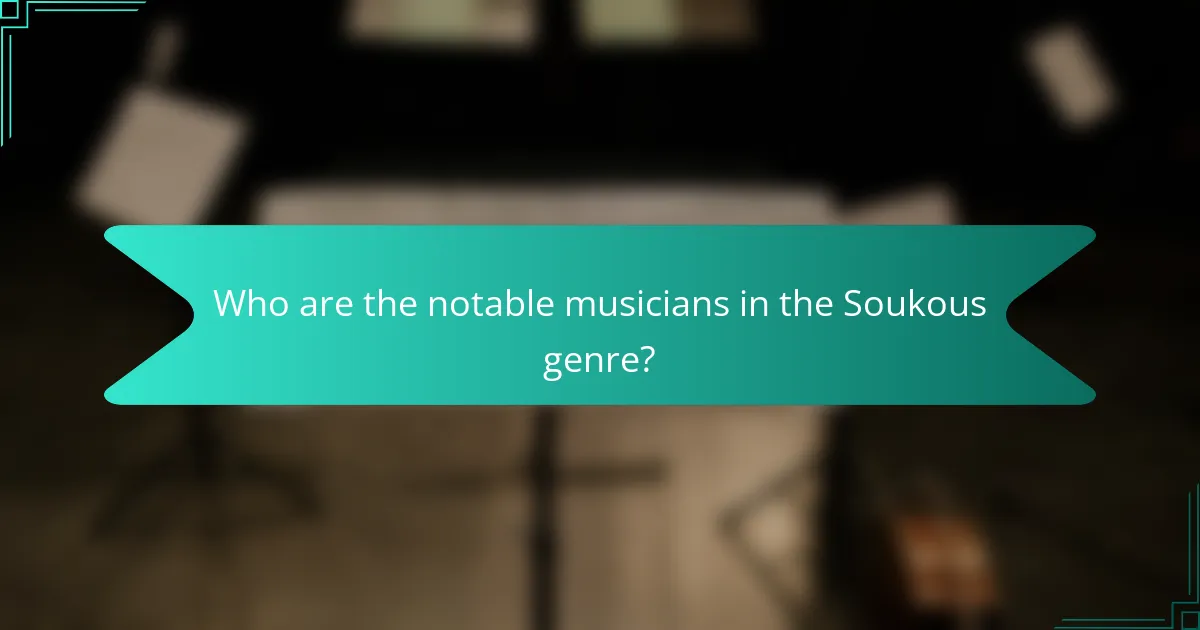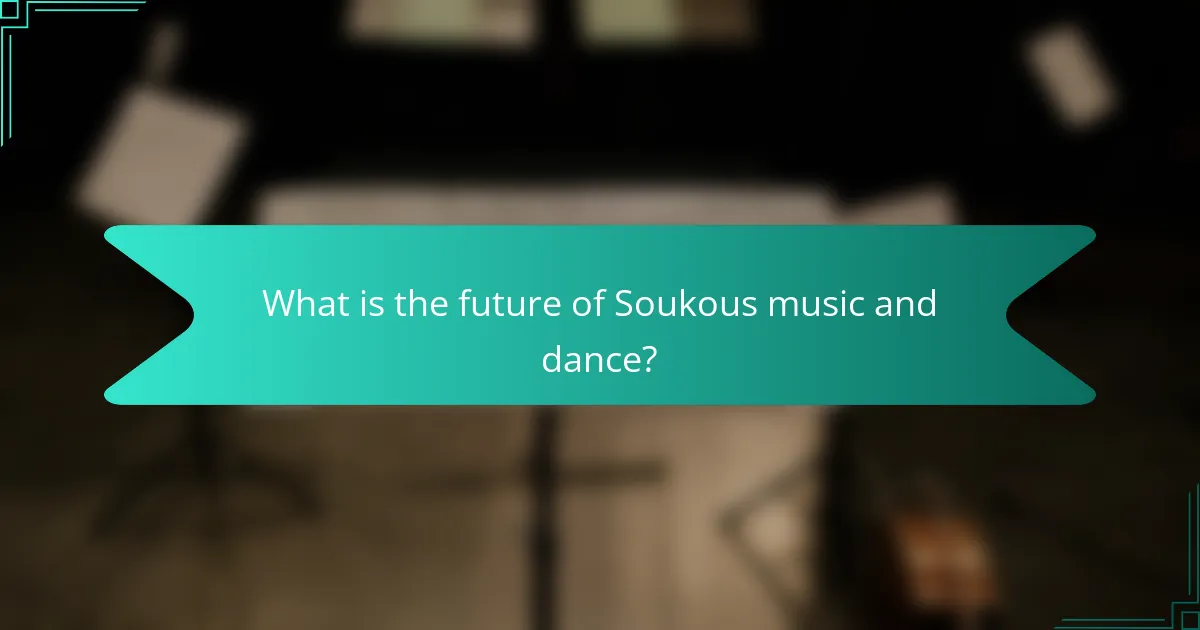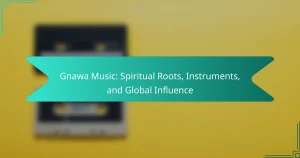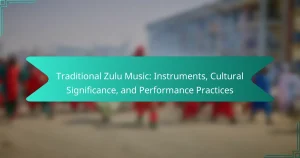Soukous is a vibrant dance music genre that originated in the Democratic Republic of the Congo, evolving from traditional Congolese rumba in the 1960s. Characterized by its upbeat tempo and intricate guitar melodies, Soukous incorporates a mix of African rhythms and Western influences. Key musicians such as Franco Luambo, Tabu Ley Rochereau, and Papa Wemba have significantly contributed to the genre’s development and global recognition. The future of Soukous looks promising, as it continues to blend with contemporary styles like Afrobeat and hip-hop, attracting younger audiences and benefiting from advancements in technology and global music platforms. Festivals celebrating African music further promote Soukous, ensuring its ongoing relevance in cultural exchange.

What is Soukous?
Soukous is a popular dance music genre originating from the Democratic Republic of the Congo. It evolved from traditional Congolese rumba in the 1960s. The genre is characterized by its upbeat tempo and intricate guitar melodies. Soukous often features a blend of African rhythms and Western musical influences. Notable musicians in this genre include Franco Luambo and Papa Wemba. Soukous has significantly influenced various music styles across Africa and beyond. The genre remains a vital part of Congolese culture and music today.
How did Soukous originate and evolve over time?
Soukous originated in the 1930s in the Congo region. It evolved from traditional Congolese rumba, which was influenced by Cuban music. The genre gained popularity in the 1940s and 1950s with the introduction of electric instruments. Soukous incorporates fast-paced rhythms and guitar solos. By the 1960s, it became a dominant music style in Central Africa. Notable musicians like Franco Luambo and Tabu Ley Rochereau contributed to its development. The 1980s saw a fusion of soukous with other genres like reggae and funk. This evolution led to a global appreciation of soukous music.
What cultural influences shaped the development of Soukous?
Soukous developed through a blend of African, European, and Caribbean cultural influences. Its roots can be traced to Congolese rumba, which incorporated traditional African rhythms and melodies. The arrival of Belgian colonialism introduced European musical elements, particularly from jazz and Latin music. Additionally, Caribbean influences, especially from the Cuban son, enriched Soukous with new rhythms and instrumentation. The fusion of these diverse influences led to the unique sound of Soukous, characterized by its upbeat tempo and danceable grooves. This genre became popular in Central and East Africa during the 1960s and 1970s, reflecting the cultural exchanges that shaped its evolution.
What are the key historical milestones in the evolution of Soukous?
Soukous evolved significantly from the 1940s to the present. In the 1940s, Congolese rumba emerged as a foundational genre. By the 1960s, the genre began to incorporate electric instruments and Western influences. The 1970s saw the rise of bands like Zaiko Langa Langa, popularizing the soukous sound. During the 1980s, soukous gained international popularity, with artists like Kanda Bongo Man and Papa Wemba achieving fame. The 1990s introduced new dance styles, further diversifying the genre. Today, soukous continues to influence various music styles globally. Each milestone reflects the genre’s adaptability and cultural significance.
What are the defining characteristics of Soukous music?
Soukous music is characterized by its upbeat tempo and intricate guitar rhythms. It originated in the Congo in the 1960s. The genre blends traditional African music with Caribbean influences. Soukous features a strong emphasis on danceability. The use of electric guitars and synthesizers is prominent. Vocal harmonies and call-and-response patterns are common. The lyrics often reflect social and cultural themes. Notable artists like Franco and Tabu Ley have popularized the genre.
How does the instrumentation in Soukous contribute to its unique sound?
Instrumentation in Soukous significantly contributes to its unique sound through a blend of traditional African and modern Western elements. The prominent use of electric guitars creates a vibrant, rhythmic foundation that is characteristic of the genre. These guitars often feature intricate solos, which add melodic complexity. The incorporation of percussion instruments, such as drums and congas, enhances the danceable quality of Soukous music. Bass lines are typically prominent, providing depth and groove to the overall sound. Additionally, keyboards and synthesizers contribute to the harmonic richness and modern feel of the music. The combination of these instruments creates a lively, energetic atmosphere that is distinct to Soukous. This fusion of instrumentation has roots in Congolese music traditions while embracing contemporary influences, making Soukous a dynamic and evolving genre.
What role do rhythms and melodies play in Soukous music?
Rhythms and melodies are fundamental elements of Soukous music. They create a vibrant and energetic sound that is essential for dance. Rhythms in Soukous often feature syncopation and polyrhythms, driving the tempo and encouraging movement. Melodies are typically catchy and repetitive, making them memorable for listeners. The interplay between rhythms and melodies gives Soukous its distinctive feel. This combination facilitates social interaction during performances and dance events. Historically, Soukous evolved from traditional Congolese music, incorporating influences from various genres. These elements contribute to the genre’s widespread popularity across Africa and beyond.
What dance styles are associated with Soukous?
The dance styles associated with Soukous include Ndombolo and Congo Dance. Ndombolo is characterized by energetic movements and rhythmic footwork. It emerged in the 1990s as a popular dance form within the Soukous genre. Congo Dance features fluid body movements and emphasizes hip motion. Both styles reflect the vibrant culture of the Democratic Republic of the Congo. Soukous music often inspires these dances, showcasing the connection between rhythm and movement. The popularity of these dance styles has spread beyond Africa, influencing global dance trends.
How do different dance styles reflect the essence of Soukous music?
Different dance styles reflect the essence of Soukous music through their rhythmic movements and cultural expressions. Soukous, originating from the Democratic Republic of the Congo, is characterized by its upbeat tempo and intricate guitar melodies. Dance styles such as the Ndombolo and the Lingala embody these musical elements with energetic footwork and hip movements. The Ndombolo emphasizes fast-paced, syncopated steps that mirror the lively guitar riffs in Soukous. Similarly, Lingala dance incorporates fluid body movements, showcasing the genre’s emphasis on rhythm and groove. These dance styles not only celebrate the music but also connect to the cultural heritage of the Congolese people. The vibrant dance scenes at Soukous performances highlight the communal spirit and joy that the music brings, reinforcing its cultural significance.
What are the most popular dance styles linked to Soukous?
The most popular dance styles linked to Soukous include Ndombolo, which emphasizes hip movements and energetic footwork. Another notable style is the Soukous dance, characterized by fast-paced rhythms and lively body movements. Additionally, the Makossa dance, originating from Cameroon, is often associated with Soukous and features smooth, flowing motions. These dance styles reflect the vibrant and dynamic nature of Soukous music. They have evolved from traditional African dances, integrating modern elements that appeal to contemporary audiences. The popularity of these styles is evidenced by their presence in music videos and dance competitions across Africa and beyond.

Who are the notable musicians in the Soukous genre?
Notable musicians in the Soukous genre include Franco Luambo, Tabu Ley Rochereau, and Papa Wemba. Franco Luambo is often regarded as the king of Soukous and was influential in shaping the genre. Tabu Ley Rochereau, known for his smooth voice and complex arrangements, contributed significantly to its popularity. Papa Wemba was a prominent figure who blended Soukous with other musical styles, gaining international fame. These artists have played crucial roles in the development and global recognition of Soukous music.
What impact have key Soukous musicians had on the genre?
Key Soukous musicians have significantly shaped the genre’s development and popularity. Artists like Franco Luambo, Tabu Ley Rochereau, and Papa Wemba introduced innovative rhythms and melodies. Their contributions helped to modernize traditional Congolese music. Franco’s band, OK Jazz, was pivotal in popularizing Soukous across Africa and beyond. Tabu Ley’s fusion of various styles expanded the genre’s appeal. Papa Wemba, known as the “king of Rumba Rock,” attracted international audiences. These musicians also influenced younger generations, ensuring the genre’s evolution. Their legacies continue to inspire contemporary Soukous artists today.
Which musicians are considered pioneers of Soukous?
The musicians considered pioneers of Soukous include François Luambo Makiadi, often known as Franco. He is recognized for popularizing the genre in the 1960s and 1970s. Another key figure is Tabu Ley Rochereau, who contributed significantly to its development and international appeal. These musicians played a crucial role in shaping Soukous music through their innovative styles and compositions. Franco’s band, OK Jazz, became a leading force in the genre. Tabu Ley’s influence extended beyond music to fashion and culture. Their contributions established Soukous as a prominent genre in African music history.
What contributions have contemporary artists made to Soukous?
Contemporary artists have revitalized Soukous by integrating diverse musical influences. They incorporate elements from genres like hip-hop, R&B, and reggae. This fusion creates a fresh sound that appeals to younger audiences. Artists like Fally Ipupa and Koffi Olomide have led these innovations. They blend traditional Soukous rhythms with modern production techniques. This has expanded Soukous’ reach beyond Africa. Collaborations with international artists have also increased its global visibility. Contemporary artists are crucial in keeping Soukous relevant in today’s music scene.
How have notable musicians influenced the global perception of Soukous?
Notable musicians have significantly influenced the global perception of Soukous through their international collaborations and performances. Artists like Papa Wemba and Koffi Olomide brought Soukous to global audiences by incorporating diverse musical elements. Their music often features catchy rhythms and danceable beats, appealing to a wide range of listeners. Additionally, these musicians have performed in major international venues, showcasing Soukous to new markets.
The fusion of Soukous with other genres, such as pop and jazz, has further expanded its reach. This blending has attracted attention from music enthusiasts worldwide. The rise of digital platforms has also allowed these musicians to share their work globally, enhancing Soukous’s visibility. Through their influence, notable musicians have transformed Soukous from a regional genre into a recognized global phenomenon.
What collaborations have helped popularize Soukous internationally?
Collaborations with international artists have significantly popularized Soukous. Notable partnerships include those with musicians like Papa Wemba and his work with artists from France. The collaboration between Koffi Olomide and various African and European musicians also contributed to its global reach. Additionally, the fusion of Soukous with genres like reggae and pop has attracted wider audiences. Events like the Festival International de la Musique de Kinshasa showcased Soukous to international crowds. These collaborations and performances have helped elevate the genre’s profile worldwide.
How do these musicians incorporate traditional elements into their work?
Musicians in Soukous incorporate traditional elements by blending African rhythms with modern styles. They often use traditional instruments such as the likembe or ngoma alongside electric guitars and synthesizers. This fusion creates a unique sound that respects cultural heritage while appealing to contemporary audiences. Additionally, vocalists may infuse local languages and proverbs into their lyrics. Dance movements reflect traditional African dances, enhancing the cultural authenticity of performances. Notably, artists like Franco and Tabu Ley have been instrumental in this integration, showcasing traditional melodies within their compositions. This approach helps preserve cultural identity in a rapidly evolving musical landscape.

What is the future of Soukous music and dance?
The future of Soukous music and dance appears promising due to its evolving nature. The genre is increasingly blending with contemporary styles like Afrobeat and hip-hop. This fusion attracts younger audiences and keeps the genre relevant. Additionally, advancements in technology facilitate global access to Soukous music. Streaming platforms enable artists to reach international fans. Collaborations with global musicians also enhance its visibility. Festivals celebrating African music often feature Soukous, promoting cultural exchange. Overall, the adaptability of Soukous suggests a vibrant future ahead.
How is Soukous evolving in the contemporary music scene?
Soukous is evolving by integrating modern musical influences and technology. Contemporary artists are blending traditional Soukous rhythms with genres like hip-hop and electronic music. This fusion creates a fresh sound that appeals to younger audiences. Additionally, the use of digital platforms for distribution is increasing Soukous’s global reach. Artists are also collaborating with international musicians, further diversifying the genre. The evolution is evident in the rise of new Soukous stars who incorporate various styles into their music. Festivals and online streaming have boosted the genre’s visibility. Overall, Soukous is adapting to contemporary trends while maintaining its cultural roots.
What trends are emerging within the Soukous genre today?
Emerging trends in the Soukous genre today include the fusion of traditional sounds with modern genres. Artists are increasingly incorporating elements of hip-hop, reggae, and electronic music into their compositions. This blending creates a fresh sound that appeals to younger audiences. Collaborations between Soukous musicians and international artists are becoming more common. These partnerships enhance the genre’s global reach and influence. Additionally, digital platforms are facilitating the distribution of Soukous music, making it accessible worldwide. Social media is also playing a significant role in promoting new Soukous artists and trends. The revival of classic Soukous styles is notable, with some musicians paying homage to legendary figures in the genre. Overall, these trends indicate a dynamic evolution within Soukous music.
How are new technologies affecting the production and distribution of Soukous?
New technologies are significantly enhancing the production and distribution of Soukous music. Digital audio workstations allow for high-quality recording and mixing. This technology enables musicians to produce tracks more efficiently and creatively. Additionally, streaming platforms have transformed how Soukous is distributed. Artists can reach global audiences without traditional record label support. Social media platforms also facilitate direct engagement with fans. These technologies enable real-time feedback and promotion for Soukous artists. Data analytics from streaming services help musicians understand their audience better. Overall, technology is democratizing the production and distribution landscape of Soukous music.
What practical tips can be applied to enjoy and engage with Soukous?
To enjoy and engage with Soukous, immerse yourself in its rhythmic dance styles. Learn the basic footwork associated with Soukous to participate actively. Attend live performances to experience the energy and community atmosphere. Listen to notable Soukous musicians like Papa Wemba and Koffi Olomide to appreciate the genre’s rich history. Join dance classes focused on Soukous to enhance your skills and enjoyment. Explore online platforms for Soukous music and dance tutorials. Engage with communities or forums that discuss Soukous to share experiences and tips. Finally, practice regularly to build confidence and deepen your connection to the music and dance.
How can one learn to dance to Soukous music effectively?
To learn to dance to Soukous music effectively, one should start by understanding its rhythm and style. Soukous features a fast-paced, lively beat that encourages energetic movements. Listening to various Soukous tracks helps develop an ear for the music. Observing experienced dancers can provide valuable insights into the dance style. Practicing basic steps and footwork is essential for mastering the dance. Taking lessons from a qualified instructor can accelerate the learning process. Engaging in regular practice solidifies skills and builds confidence. Joining a dance group allows for social interaction and further skill enhancement.
What resources are available for discovering new Soukous artists and songs?
Streaming platforms like Spotify and Apple Music feature playlists dedicated to Soukous music. These playlists often highlight new and emerging artists. Social media platforms such as Instagram and TikTok also showcase Soukous artists through user-generated content. Websites like YouTube have channels specifically for Soukous music, offering a wide variety of songs and artist showcases. Music blogs and online magazines often review and promote new Soukous releases. Local radio stations in regions where Soukous is popular frequently play new tracks and feature interviews with artists. Concerts and music festivals focusing on African music often introduce audiences to new Soukous talent.
Soukous is a vibrant dance music genre that originated in the Democratic Republic of the Congo, evolving from traditional Congolese rumba in the 1960s. The article explores its historical development, key cultural influences, and defining characteristics, including its upbeat tempo and intricate guitar melodies. Notable musicians such as Franco Luambo, Tabu Ley Rochereau, and Papa Wemba significantly shaped the genre, while contemporary artists continue to innovate by blending Soukous with modern styles. Additionally, the article highlights associated dance styles, emerging trends, and the future of Soukous in the global music landscape.




